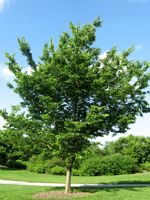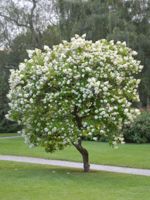Mon-Fri 9am - 5pm Mountain time
Common Hackberry vs Japanese Tree Lilac
Celtis occidentalis
Syringa reticulata
NOT AVAILABLE THIS SEASON - MIGHT RETURN
The Common Hackberry is a medium-sized deciduous tree that resembles the American Elm but is immune to Dutch Elm Disease. They are versatile and can adapt to a variety of growing conditions.
It produces purple-red, berry-like fruit with a large seed in the center. Both the sweet flesh, which tastes similar to dates, and the crunchy seed are edible. The fruit remains on the tree throughout the winter, offering a valuable food source for birds and other wildlife.
The Common Hackberry can also be a great addition to a pollinator garden. The tree itself is a host for the larvae of several butterfly species and the flowers provide a source of pollen and nectar.
Japanese Tree Lilac is an attractive, heavy-flowering lilac with fragrant white blossoms. It can be pruned to a single stem or grown as a multi-stemmed shrub.
Japanese Tree Lilac's dark reddish-brown bark peels as the tree ages, creating visual appeal for any yard, especially in the winter.
This tree is often planted along boulevards and its attractive white flowers signal spring to all who drive by.
Common Hackberry Quick Facts
Japanese Tree Lilac Quick Facts
In row spacing: 0.9 m (3 ft)

